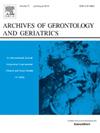Novel plasma protein biomarkers: A time-dependent predictive model for Alzheimer's disease
IF 3.5
3区 医学
Q2 GERIATRICS & GERONTOLOGY
引用次数: 0
Abstract
Background
The accurate prediction of Alzheimer's disease (AD) is crucial for the efficient management of its progression. The objective of this research was to construct a new risk predictive model utilizing novel plasma protein biomarkers for predicting AD incidence in the future and analyze their potential biological correlation with AD incidence.
Methods
A cohort of 440 participants aged 60 years and older from the Alzheimer's Disease Neuroimaging Initiative (ADNI) longitudinal cohort was utilized. The baseline plasma proteomics data was employed to conduct Cox regression, LASSO regression, and cross-validation to identify plasma protein signatures predictive of AD risk. Subsequently, a multivariable Cox proportional hazards model based on these signatures was constructed. The performance of the risk prediction model was evaluated using time-dependent receiver operating characteristic (t-ROC) curves and Kaplan-Meier curves. Additionally, we analyzed the correlations between protein signature expression in plasma and predicted AD risk, the time of AD onset, the expression of protein signatures in cerebrospinal fluid (CSF), the expression of CSF and plasma biomarkers, and APOE ε4 genotypes. Colocalization and Mendelian randomization analyses was conducted to investigate the association between protein features and AD risk. GEO database was utilized to analyze the differential expression of protein features in the blood and brain of AD patients.
Results
We identified seven protein signatures (APOE, CGA, CRP, CCL26, CCL20, NRCAM, and PYY) that independently predicted AD incidence in the future. The risk prediction model demonstrated area under the ROC curve (AUC) values of 0.77, 0.76, and 0.77 for predicting AD incidence at 4, 6, and 8 years, respectively. Furthermore, the model remained stable in the range of the 3rd to the 12th year (ROC ≥ 0.74). The low-risk group, as defined by the model, exhibited a significantly later AD onset compared to the high-risk group (P < 0.0001). Moreover, all protein signatures exhibited significant correlations with AD risk (P < 0.001) and the time of AD onset (P < 0.01). There was no strong correlation between the protein expression levels in plasma and CSF, as well as AD CSF biomarkers. APOE, CGA, and CRP exhibited significantly lower expression levels in APOE ε4 positive individuals (P < 0.05). Additionally, colocalization analysis reveals a significant association between AD and SNP loci in APOE. Mendelian randomization analysis shows a negative correlation between NRCAM and AD risk. Transcriptomic analysis indicates a significant downregulation of NRCAM and PYY in the peripheral blood of AD patients (P < 0.01), while APOE, CGA, and NRCAM are significantly downregulated in the brains of AD patients (P < 0.0001).
Conclusion
Our research has successfully identified protein signatures in plasma as potential risk biomarkers that can independently predict AD onset in the future. Notably, this risk prediction model has demonstrated commendable predictive performance and stability over time. These findings underscore the promising utility of plasma protein signatures in dynamically predicting the risk of AD, thereby facilitating early screening and intervention strategies.
新型血浆蛋白生物标志物:随时间变化的阿尔茨海默病预测模型。
背景:准确预测阿尔茨海默病(AD)对于有效控制其发展至关重要。本研究的目的是利用新型血浆蛋白生物标志物构建一个新的风险预测模型,用于预测未来阿尔茨海默病的发病率,并分析其与阿尔茨海默病发病率的潜在生物学相关性:方法:利用阿尔茨海默病神经影像学倡议(ADNI)纵向队列中440名60岁及以上的参与者。利用基线血浆蛋白质组学数据进行了Cox回归、LASSO回归和交叉验证,以确定可预测AD风险的血浆蛋白质特征。随后,根据这些特征构建了一个多变量考克斯比例危险模型。我们使用随时间变化的接收者操作特征曲线(t-ROC)和 Kaplan-Meier 曲线评估了风险预测模型的性能。此外,我们还分析了血浆中蛋白质特征表达与预测的AD风险、AD发病时间、脑脊液(CSF)中蛋白质特征表达、CSF和血浆生物标志物表达以及APOE ε4基因型之间的相关性。通过共定位和孟德尔随机分析,研究了蛋白质特征与AD风险之间的关联。利用GEO数据库分析了AD患者血液和大脑中蛋白质特征的差异表达:结果:我们发现了七个蛋白质特征(APOE、CGA、CRP、CCL26、CCL20、NRCAM 和 PYYY)可以独立预测未来的 AD 发病率。风险预测模型的 ROC 曲线下面积 (AUC) 值分别为 0.77、0.76 和 0.77,可预测 4、6 和 8 年后的 AD 发病率。此外,该模型在第 3 年至第 12 年期间保持稳定(ROC ≥ 0.74)。与高风险组相比,该模型所定义的低风险组明显晚于高风险组(P < 0.0001)。此外,所有蛋白质特征都与AD风险(P<0.001)和AD发病时间(P<0.01)有显著相关性。血浆和脑脊液中的蛋白质表达水平与AD脑脊液生物标志物之间没有很强的相关性。APOE, CGA 和 CRP 在 APOE ε4 阳性个体中的表达水平明显较低(P < 0.05)。此外,共定位分析表明,AD 与 APOE 中的 SNP 位点有明显关联。孟德尔随机分析显示,NRCAM与AD风险呈负相关。转录组分析表明,NRCAM和PYY在AD患者外周血中明显下调(P < 0.01),而APOE、CGA和NRCAM在AD患者大脑中明显下调(P < 0.0001):我们的研究成功地发现了血浆中的蛋白质特征,它们是潜在的风险生物标志物,可以独立预测未来的AD发病。值得注意的是,这一风险预测模型具有值得称道的预测性能和长期稳定性。这些发现强调了血浆蛋白特征在动态预测AD风险方面的巨大作用,从而有助于早期筛查和干预策略。
本文章由计算机程序翻译,如有差异,请以英文原文为准。
求助全文
约1分钟内获得全文
求助全文
来源期刊
CiteScore
7.30
自引率
5.00%
发文量
198
审稿时长
16 days
期刊介绍:
Archives of Gerontology and Geriatrics provides a medium for the publication of papers from the fields of experimental gerontology and clinical and social geriatrics. The principal aim of the journal is to facilitate the exchange of information between specialists in these three fields of gerontological research. Experimental papers dealing with the basic mechanisms of aging at molecular, cellular, tissue or organ levels will be published.
Clinical papers will be accepted if they provide sufficiently new information or are of fundamental importance for the knowledge of human aging. Purely descriptive clinical papers will be accepted only if the results permit further interpretation. Papers dealing with anti-aging pharmacological preparations in humans are welcome. Papers on the social aspects of geriatrics will be accepted if they are of general interest regarding the epidemiology of aging and the efficiency and working methods of the social organizations for the health care of the elderly.

 求助内容:
求助内容: 应助结果提醒方式:
应助结果提醒方式:


